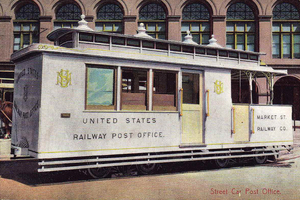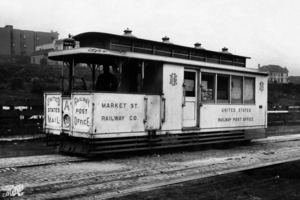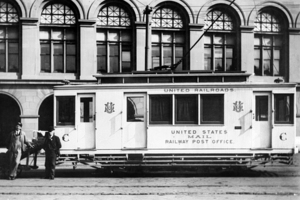As part of our mission, Market Street Railway creates displays on-board the historic streetcars to educate San Franciscans and visitors on interesting aspects of the city’s transit history. We call it the Museums in Motion project. This is an online version of one of those displays.
Cities require commerce to prosper. Getting parcels and letters delivered quickly has always been important. In San Francisco around the turn of the 20th century, cable cars and streetcars filled a role that delivery vans and bicycle messengers do today.
In the early 1890s, the United States Post Office Department began nationwide studies to speed up city mail delivery and processing by using local rail transit systems. Washington-based Post Office officials believed that Railway Post Offices (RPO), where clerks sorted mail as long-haul trains rumbled between cities, would be a good idea within cities as well. San Francisco Postmaster Frank McCoppin, a former mayor, thought distances inside the city were too short to make it practical here.
Washington won, and in 1896, the Market Street Railway Co., then owned by Southern Pacific Railroad interests, received a contract for Railway Post Office service and built three special cars–two cable cars and an electric streetcar–painted in the government-required bright white with gold trim. The cars even had mail slots in the side, allowing San Franciscans to walk up to the car and drop in their letters, which clerks onboard would promptly sort. In 1900, ‘closed pouch’ service was added, hauling sealed mailbags between the ferry terminal and various post offices around town. Sometimes mailbags were carried on passenger cable cars as well.
By 1905, postal officials realized that McCoppin was right: cable car and streetcar Railway Post Offices didn’t work well in San Francisco, and so discontinued them. The closed pouch services continued until the earthquake and fire of April 18, 1906, but weren’t resumed when transit service was restored. The Post Office switched back to horse and wagon teams, then to early motor trucks.
Today, when parcels zip from China to San Francisco overnight, it’s hard to imagine the effort made to save a few minutes in carrying parcels across town. But it’s part of our transit history.



Nice page! Anyone seeking more information about the San Francisco Street Railway Post Offices should read a monograph on the subject published by the Mobile Post Office Society. You may contact the Railway Mail Service Library for more information, at 117 East Main Street, Boyce, Virginia 22620-9639 www railwaymailservicelibrary org (add dots) Best wishes, Frank Scheer
One trolley RPO survives in running condition: Portsmouth, Dover and York 108 at Seashore Trolley Museum. Last October it was running as the “Pumpkin Car” delivering from Seashore’s pumpkin patch to the terminal area of the museum. Since it was converted into a work car long ago, it takes a bit of traction archaeology to find evidence of its days as part of the postal system. The body of a Pacific Electric RPO is preserved at Orange Empire; it was converted into a non-electrified work car and wound up as a salvage yard office.